Shoots for Identification
Woody bamboo rarely flowers. Often at intervals of decades and multiple decades. Herbaceous bamboos in the tropics flower annually. The taxonomy of flowering plants is based on reproductive organs. Bamboos were not flowering when European botanists and plant explorers were discovering bamboos in Asia. With no reproductive organs to examine, they could not determine genus and species. If you can’t classify the bamboo, you can’t scientifically name it.
Taxonomy of bamboos has been changing over the decades because when a rare flowering happens scientists rename the bamboo if appropriate.
Identification of the genus of large woody bamboos can often done by features such as size and color of cane, number and arrangement of branches, texture of skin, size of leaves, and relative length of internodes of culm. However, to identify the species, the culm leaf of the shoot is often necessary. With most flowering plants, the flowers and seeds are used to identify in the field. With the bamboos, we use the culm leaf. Even a dried culm leaf left in the grove after shooting is useful for identification.
The late Richard Haubrich, founder of the American Bamboo Society, wrote a concise scientific description of many Phyllostachys bamboos in Journal of the American Bamboo Society, 1980. Below is his description of Japanese Timber/Phyllostachys bambusoides. I include it to give you an idea of how to identify a bamboo, assuming it is mature. Juvenile bamboos can be hard to identify because their mature characteristics are not yet there. Ned Jaquith, founder of The Bamboo Garden in Oregon and noted expert on hardy bamboos, said that the way to identify a juvenile bamboo in a pot is by reading the label. He also identified dwarf bamboos spreading in alleys as “Little green bamboo”. Those of us who knew Ned Jaquith, loved him.
“Culms to 72 ft. tall and 5 3/4 in. in diameter, erect or nearly so, relatively straight; internodes up to 17 in. long on a culm 48 ft. long, green, hairless, without white powder at sheath fall, usually not ribbed; nodal ridges about as prominent as the sheath scars; sheath scars thin, hairless, not strongly flared. Culm leaf sheaths greenish to ruddy buff, densely spotted with dark brown; auricles usually developed at nodes above the basal ones, with greenish crinkled oral setae; ligules moderately well developed, the apex convex and fringed with minute hairs on smaller culms, the apex nearly straight and fringed with coarse bristles on larger ones; blades short, lance-shaped, bent back and crinkled in lower sheaths to long, strap-shaped and curved back in upper ones, green down the middle, with an equally wide band of blended wine, green, and buff on each side, and a narrow margin of cream. Foliage leaves usually with auricles and oral setae well developed; ligules well developed; blades up to 7 1/2 by 1 1/4 in. commonly from 1 5/8 by 1/2 to 6 7/8 by 1 in.”
In Haubrich’s precise description, you read the taxonomic terms for bamboo. Because bamboo is a grass, these terms are the same as for describing grass. Grass farmers will be familiar with these terms.
Culm is a cane. A pole is a culm after it is harvested. Internode is the hollow part of the culm between nodes. Bamboos have three kinds of leaf: foliage leaf, culm leaf and rhizome leaf. Culm leaf is the specialized leaf that covers the new shoot. Each species has a distinct culm leaf. It is from these leaves that look-alike bamboos can be distinguished and identified. The culm leaf has the hormones that cause the internode to extend. The sheath of the culm leaf attaches to the node of the shoot. Usually there are two raised rings marking the node. The lower ring is the sheath scar. It is where the sheath of the culm leaf attached while it was alive. The upper ring is the nodal ridge. In moso you do not see the nodal ridge. In Phyllostachys bamboos, the culm leaf dies and falls off when its internode finishes extending. It leaves a scar showing where it had attached.
Shoots change their looks as they elongate. They are prime for harvesting, when they are about a week out of the ground. They look short and fat. Egg like. Their leaf blades are still tight and pointed, not long enough to be useful for identification. These pointed leaf blades spear the ground as the shoot extend upwards. Once in the air, the blades lengthen and open outwards from the shoot. They become soft and flexible. They become typical of a particular variety of bamboo. The sheath of the culm leaf is large relative to the blade and other parts. Sometimes the culm leaf is called the sheath leaf.
Phyllostachys bambusoides
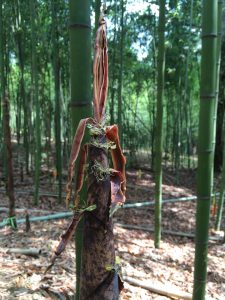
max ht 72′; max diam 6″; min temp 5°F
Japanese Timber is the last to shoot. Often it does not poke out of the ground until May in middle Georgia, USDA Zone 8. Its late shooting time extends the harvest season. The shoot is blotched darker and more uniformly brown than my other shoots. Hairless. I love the crinkly, bright green oral Setae. The colorful blades mix green, wine, and cream.
Bambusoides is slow to mature. My groves were planted 4/2014. I have not logged harvesting shoots from it yet.
A Japanese timber shoot is handsome in a box of shoots. Photo is from an established grove belonging to Robby Russell.
Soil is 63°F (17°C) or more at time of shooting.
Phyllostachys dulcis
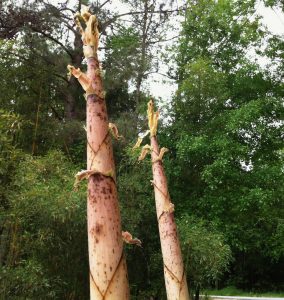
max ht 40′; max diam 2.8″; min temp 0°F
‘Sweetshoot Bamboo, Vegetable Bamboo.
Dulcis has pinkish hairless shoots with scattered small brown spots. The leaf blades are strongly crinkled. It is an early shooter, later than praecox, a week after moso. Dulcis shoots are tender. They are easy to dig because they are not tough like moso.
Dulcis is named for the sweet and agreeable taste of its shoots. Frank Meyer (1875-1918) introduced it to the United States in 1908 from Zhejiang Province, China. He described P. dulcis as “the edible bamboo grown in nearly every backyard in Central China”. Ned Jaquith noted that Dulcis sizes up quickly from a new planting.
Dulcis is a good choice for a suburban grove because it looks impressive (and so pretty) without being excessively tall.
Soil is 60°F (15.6°C) at time of shooting.
Phyllostachys edulis (formerly P. pubescens)

max ht 75′ max diam 7.0″ min temp 5°F
Moso is the easiest shoot to identify. From a distance the grove has its canes tipping outwards. Most Phyllostachys have canes that stand erect. Moso has large diameter culms with fuzzy hair on the younger culms. Shoots are sold by the pound, so large size is an advantage. The shoots are dark brown and covered with hairs. Bright green leaf blades are arranged like a crown over the top of the shoot. The hairs catch dirt as they emerge. We wipe them carefully before boxing them to send to customers. Taste is bitter so peel, slice thin, and boil in water with salt and vinegar for 20 minutes. Rinse and add to recipe, or refrigerate for later use.
Soil is 58°F (14.4°) at time of shooting. Moso shoots early right after praecox. It shoots for seven weeks.
Phyllostachys nidularia Big Node Bamboo
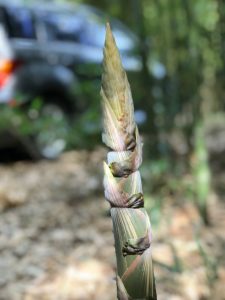 max ht 33′ max diam 1.5″ min temp 5°F
max ht 33′ max diam 1.5″ min temp 5°F
From the Latin word nidulans which means nesting and the suffix -arium which is a place where something is done. Perhaps it is because the base of the leaf blade wraps around the shoot, nesting it.
Big Node Bamboo has the most colorful shoots of all. They look great in a shipping box. They max out at an inch and a half. I like this size because I like to slice the shoots into rounds (rings) and drop them into the pan for stir fries. The poles are strong and versatile. The nodes bulge more than other bamboos.
Soil is 61°F (16°C) when shooting begins.
Phyllostachys nigra v. henon Giant Grey Bamboo
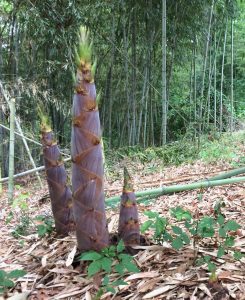
max ht 65°F; max diam 4.5″ min temp 0F
Henon culm leaves have a lavender hue. They have sparse brown or rust hairs that remain on the dry culm leaf and assist identification outside of shooting time. There are no spots. Prominent auricles. Blades wavy. Shoots in early mid-season.
Culms have a coating of grey that peels off when dried. Poles are relatively thin walled but strong and straight. Strips are good for weaving items like baskets, toy birds, fish traps.
Soil is 60°F (15.6° C) when shooting begins. Shooting is late in season.
Phyllostachys praecox Early Bamboo
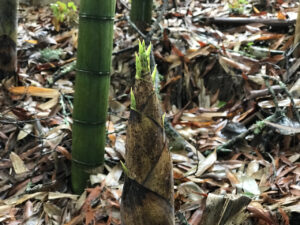
max ht 33′ max diam 2.0″ min temp 5°F
Praecox derives from ‘precocious’ meaning early. This bamboo is the first to shoot in spring. It has a longer period of shooting than other bamboos, sometimes from early March into April. Most other bamboos wait for the soil to be at least 60°. (In 2023 season was barely two weeks.) Shoots are smooth skinned and clean when harvested.
Poles three inches in diameter and straight. Dried pole has a dappled cloud of dark pigment over the normal bamboo blond.
Soil is 53°- 60°F (11.7 – 15.6°C) when shooting begins.
Phyllostachys viridis v. Houzeau
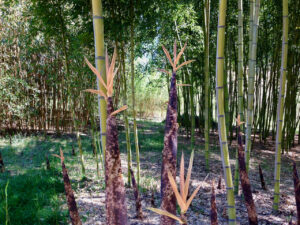
max ht 45′ max diam 3.0″ min temp 0°F
Houzeau has smooth fat shoots. Hairless with brown blotches. The older shoots have eye catching peach-colored blades. The poles grow with a gentle S shape. Poles are useful for construction if short sections are used. Great for charcoal.
“Nodal ridges imperceptible or nearly so at unbranched nodes; sheath scars thin;, hairless, not at all flared, the nodes marked by a broad band of white powder”. Grey with age.
Soil is 63°F (17°C) when shooting begins. Late shooter.
Phyllostachys vivax ‘Aureocaulis’
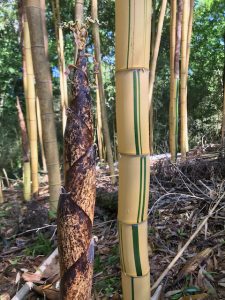 max ht 70.0′ max diam 5.0″ min temp 5°F
max ht 70.0′ max diam 5.0″ min temp 5°F
When Golden Vivax shoots grow tall enough to lose their lower culm leaves, the young culm is a stunning bright yellow. In the mature grove that I manage in Fort Valley, Georgia, the culms quickly become dull tannish yellow because they soon are covered with brown staining algae. At my own farm planted in 2014, I planted the standard green vivax. It is more vigorous than Aureocaulis.
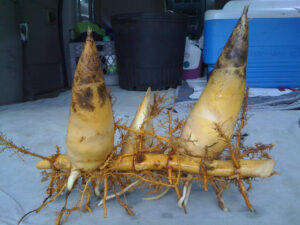 The brown part of the shoot in the adjacent photo was above ground. The cream colors were below the mulch or in the ground.
The brown part of the shoot in the adjacent photo was above ground. The cream colors were below the mulch or in the ground.
Soil is 60-61°F (15.6 – 16C) when shooting begins.